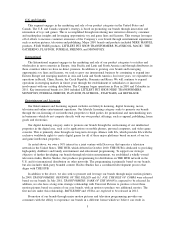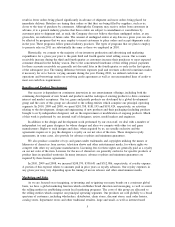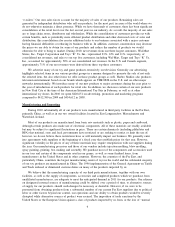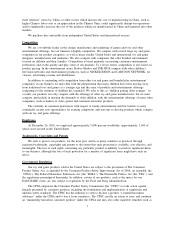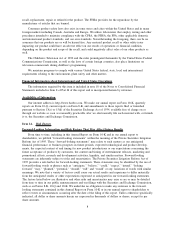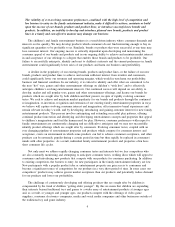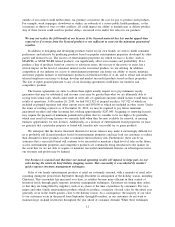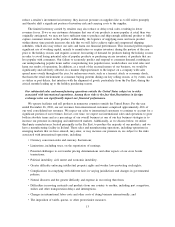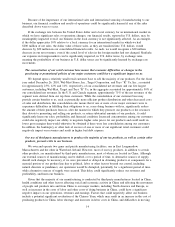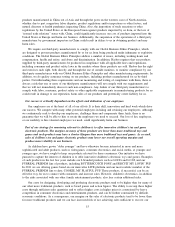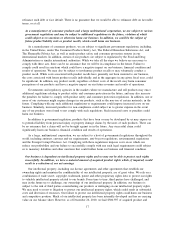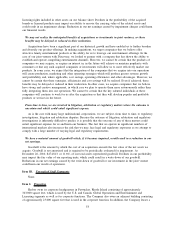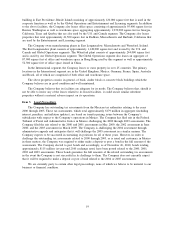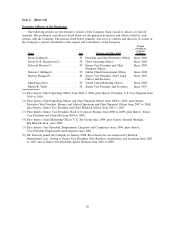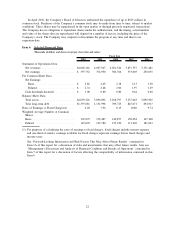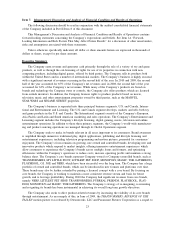Hasbro 2010 Annual Report Download - page 23
Download and view the complete annual report
Please find page 23 of the 2010 Hasbro annual report below. You can navigate through the pages in the report by either clicking on the pages listed below, or by using the keyword search tool below to find specific information within the annual report.reduce a retailer’s investment in inventory, they increase pressure on suppliers like us to fill orders promptly
and thereby shift a significant portion of inventory risk and carrying costs to the supplier.
The limited inventory carried by retailers may also reduce or delay retail sales, resulting in lower
revenues for us. If we or our customers determine that one of our products is more popular at retail than was
originally anticipated, we may not have sufficient time to produce and ship enough additional product to fully
capture consumer interest in the product. Additionally, the logistics of supplying more and more product
within shorter time periods increases the risk that we will fail to achieve tight and compressed shipping
schedules, which also may reduce our sales and harm our financial performance. This seasonal pattern requires
significant use of working capital, mainly to manufacture or acquire inventory during the portion of the year
prior to the holiday season, and requires accurate forecasting of demand for products during the holiday season
in order to avoid losing potential sales of popular products or producing excess inventory of products that are
less popular with consumers. Our failure to accurately predict and respond to consumer demand, resulting in
our underproducing popular items and/or overproducing less popular items, would reduce our total sales and
harm our results of operations. In addition, as a result of the seasonal nature of our business, we would be
significantly and adversely affected, in a manner disproportionate to the impact on a company with sales
spread more evenly throughout the year, by unforeseen events, such as a terrorist attack or economic shock,
that harm the retail environment or consumer buying patterns during our key selling season, or by events, such
as strikes or port delays, that interfere with the shipment of goods, particularly from the Far East, during the
critical months leading up to the holiday purchasing season.
Our substantial sales and manufacturing operations outside the United States subject us to risks
associated with international operations. Among these risks is the fact that fluctuations in foreign
exchange rates can significantly impact our financial performance.
We operate facilities and sell products in numerous countries outside the United States. For the year
ended December 26, 2010, our net revenues from international customers comprised approximately 46% of
our total consolidated net revenues. We expect our sales to international customers to continue to account for a
significant portion of our revenues. In fact, over time, we expect our international sales and operations to grow
both in absolute terms and as a percentage of our overall business as one of our key business strategies is to
increase our presence in emerging and underserved markets. Additionally, as we discuss below, we utilize
third-party manufacturers located principally in the Far East, to produce the majority of our products, and we
have a manufacturing facility in Ireland. These sales and manufacturing operations, including operations in
emerging markets that we have entered, may enter, or may increase our presence in, are subject to the risks
associated with international operations, including:
• Currency conversion risks and currency fluctuations;
• Limitations, including taxes, on the repatriation of earnings;
• Potential challenges to our transfer pricing determinations and other aspects of our cross border
transactions;
• Political instability, civil unrest and economic instability;
• Greater difficulty enforcing intellectual property rights and weaker laws protecting such rights;
• Complications in complying with different laws in varying jurisdictions and changes in governmental
policies;
• Natural disasters and the greater difficulty and expense in recovering therefrom;
• Difficulties in moving materials and products from one country to another, including port congestion,
strikes and other transportation delays and interruptions;
• Changes in international labor costs and other costs of doing business internationally; and
• The imposition of tariffs, quotas, or other protectionist measures.
13


